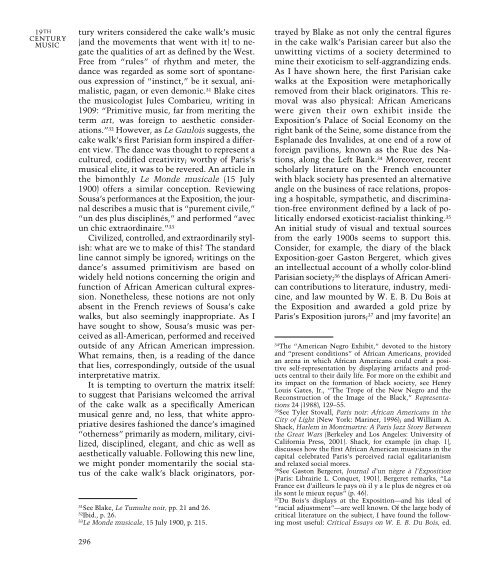Parisian Cake Walks.pdf - ResearchSpace@Auckland
Parisian Cake Walks.pdf - ResearchSpace@Auckland
Parisian Cake Walks.pdf - ResearchSpace@Auckland
You also want an ePaper? Increase the reach of your titles
YUMPU automatically turns print PDFs into web optimized ePapers that Google loves.
19TH<br />
CENTURY<br />
MUSIC<br />
tury writers considered the cake walk’s music<br />
(and the movements that went with it) to negate<br />
the qualities of art as defined by the West.<br />
Free from “rules” of rhythm and meter, the<br />
dance was regarded as some sort of spontaneous<br />
expression of “instinct,” be it sexual, animalistic,<br />
pagan, or even demonic. 31 Blake cites<br />
the musicologist Jules Combarieu, writing in<br />
1909: “Primitive music, far from meriting the<br />
term art, was foreign to aesthetic considerations.”<br />
32 However, as Le Gaulois suggests, the<br />
cake walk’s first <strong>Parisian</strong> form inspired a different<br />
view. The dance was thought to represent a<br />
cultured, codified creativity; worthy of Paris’s<br />
musical elite, it was to be revered. An article in<br />
the bimonthly Le Monde musicale (15 July<br />
1900) offers a similar conception. Reviewing<br />
Sousa’s performances at the Exposition, the journal<br />
describes a music that is “purement civile,”<br />
“un des plus disciplinés,” and performed “avec<br />
un chic extraordinaire.” 33<br />
Civilized, controlled, and extraordinarily stylish:<br />
what are we to make of this? The standard<br />
line cannot simply be ignored; writings on the<br />
dance’s assumed primitivism are based on<br />
widely held notions concerning the origin and<br />
function of African American cultural expression.<br />
Nonetheless, these notions are not only<br />
absent in the French reviews of Sousa’s cake<br />
walks, but also seemingly inappropriate. As I<br />
have sought to show, Sousa’s music was perceived<br />
as all-American, performed and received<br />
outside of any African American impression.<br />
What remains, then, is a reading of the dance<br />
that lies, correspondingly, outside of the usual<br />
interpretative matrix.<br />
It is tempting to overturn the matrix itself:<br />
to suggest that <strong>Parisian</strong>s welcomed the arrival<br />
of the cake walk as a specifically American<br />
musical genre and, no less, that white appropriative<br />
desires fashioned the dance’s imagined<br />
“otherness” primarily as modern, military, civilized,<br />
disciplined, elegant, and chic as well as<br />
aesthetically valuable. Following this new line,<br />
we might ponder momentarily the social status<br />
of the cake walk’s black originators, por-<br />
31 See Blake, Le Tumulte noir, pp. 21 and 26.<br />
32 Ibid., p. 26.<br />
33 Le Monde musicale, 15 July 1900, p. 215.<br />
296<br />
trayed by Blake as not only the central figures<br />
in the cake walk’s <strong>Parisian</strong> career but also the<br />
unwitting victims of a society determined to<br />
mine their exoticism to self-aggrandizing ends.<br />
As I have shown here, the first <strong>Parisian</strong> cake<br />
walks at the Exposition were metaphorically<br />
removed from their black originators. This removal<br />
was also physical: African Americans<br />
were given their own exhibit inside the<br />
Exposition’s Palace of Social Economy on the<br />
right bank of the Seine, some distance from the<br />
Esplanade des Invalides, at one end of a row of<br />
foreign pavilions, known as the Rue des Nations,<br />
along the Left Bank. 34 Moreover, recent<br />
scholarly literature on the French encounter<br />
with black society has presented an alternative<br />
angle on the business of race relations, proposing<br />
a hospitable, sympathetic, and discrimination-free<br />
environment defined by a lack of politically<br />
endorsed exoticist-racialist thinking. 35<br />
An initial study of visual and textual sources<br />
from the early 1900s seems to support this.<br />
Consider, for example, the diary of the black<br />
Exposition-goer Gaston Bergeret, which gives<br />
an intellectual account of a wholly color-blind<br />
<strong>Parisian</strong> society; 36 the displays of African American<br />
contributions to literature, industry, medicine,<br />
and law mounted by W. E. B. Du Bois at<br />
the Exposition and awarded a gold prize by<br />
Paris’s Exposition jurors; 37 and (my favorite) an<br />
34 The “American Negro Exhibit,” devoted to the history<br />
and “present conditions” of African Americans, provided<br />
an arena in which African Americans could craft a positive<br />
self-representation by displaying artifacts and products<br />
central to their daily life. For more on the exhibit and<br />
its impact on the formation of black society, see Henry<br />
Louis Gates, Jr., “The Trope of the New Negro and the<br />
Reconstruction of the Image of the Black,” Representations<br />
24 (1988), 129–55.<br />
35 See Tyler Stovall, Paris noir: African Americans in the<br />
City of Light (New York: Mariner, 1996); and William A.<br />
Shack, Harlem in Montmartre: A Paris Jazz Story Between<br />
the Great Wars (Berkeley and Los Angeles: University of<br />
California Press, 2001). Shack, for example (in chap. 1),<br />
discusses how the first African American musicians in the<br />
capital celebrated Paris’s perceived racial egalitarianism<br />
and relaxed social mores.<br />
36 See Gaston Bergeret, Journal d’un nègre à l’Exposition<br />
(Paris: Librairie L. Conquet, 1901). Bergeret remarks, “La<br />
France est d’ailleurs le pays où il y a le plus de nègres et où<br />
ils sont le mieux reçus” (p. 46).<br />
37 Du Bois’s displays at the Exposition—and his ideal of<br />
“racial adjustment”—are well known. Of the large body of<br />
critical literature on the subject, I have found the following<br />
most useful: Critical Essays on W. E. B. Du Bois, ed.















